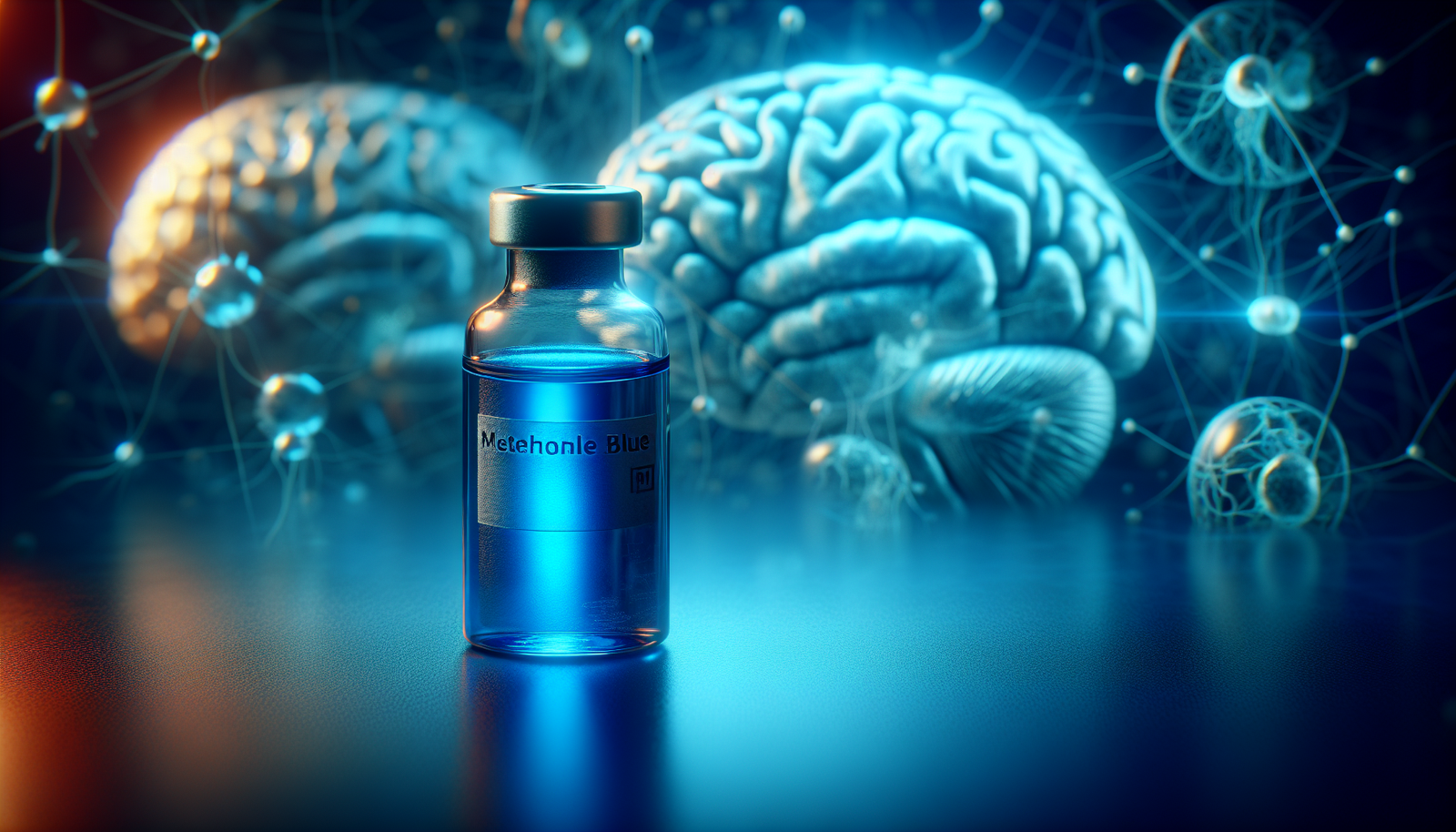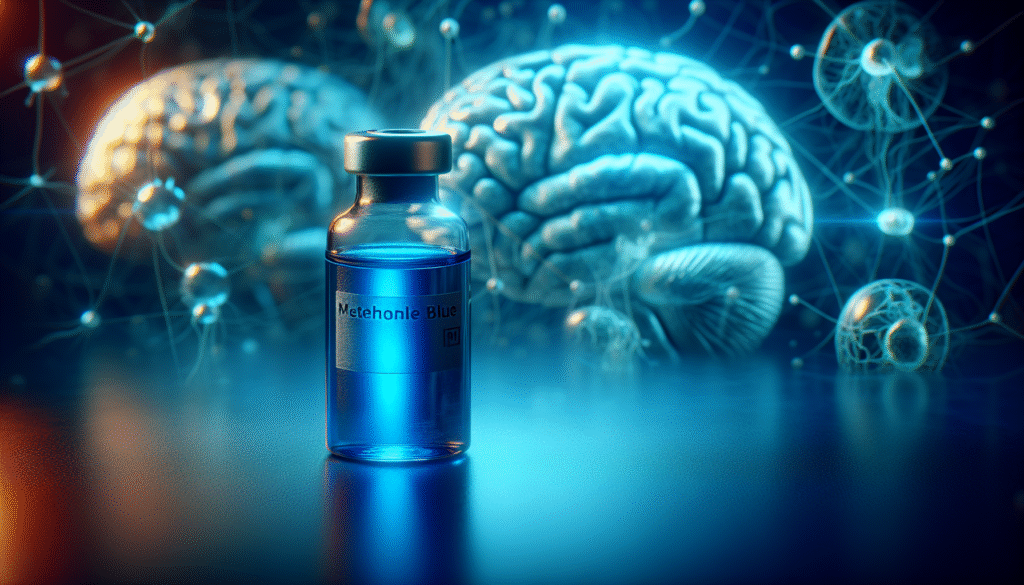
What if a single compound could illuminate our understanding of neurological disorders and potentially offer therapeutic benefits? Methylene blue, a chemical often overlooked, has regained attention within the scientific community for its intriguing properties. Many researchers are investigating its use in treating various neurological conditions, leading to a renewed interest in its effects and mechanisms of action.

Understanding Methylene Blue
Methylene blue is a synthetic dye that has been utilized for over a century in various medical and industrial applications. Originally developed as a dye for textiles, it found its first significant medical use as a treatment for malaria in the late 19th century. Today, its pharmaceutical applications extend beyond antibacterial uses to more complex areas, such as neurology.
Chemical Composition and Properties
Methylene blue (MB) is a thiazine dye, chemically known as methylene blue chloride. Its structure features a prominent positive charge, making it highly soluble in water. This water solubility allows for easy administration in medical settings. Additionally, methylene blue has antioxidant properties, which contribute to its cellular protective effects.
Mechanism of Action
The mechanism of action of methylene blue is multi-faceted, involving several biochemical pathways. It primarily acts by inhibiting monoamine oxidase (MAO), an enzyme involved in the breakdown of neurotransmitters. By inhibiting MAO, methylene blue increases the availability of these important neurotransmitters in the brain, such as serotonin, norepinephrine, and dopamine, potentially improving mood and cognitive function.
In addition to MAO inhibition, methylene blue enhances mitochondrial function. It promotes the reduction of reactive oxygen species (ROS), thereby promoting cell survival in conditions marked by oxidative stress—a hallmark of many neurological disorders.
Neurological Disorders Overview
Neurological disorders encompass a broad range of conditions that affect the brain and nervous system. Some of the most prevalent disorders include Alzheimer’s disease, Parkinson’s disease, multiple sclerosis, and depression. Each has unique pathology and symptoms but shares common underpinnings related to neuroinflammation, oxidative stress, and mitochondrial dysfunction.
Alzheimer’s Disease
Alzheimer’s disease (AD) is characterized by progressive memory loss and cognitive decline, severely impacting daily functioning. Pathologically, it is marked by the accumulation of amyloid plaques and tau tangles, leading to neuronal death and inflammation. Mitochondrial dysfunction plays a significant role in the disease’s progression.
Research indicates that methylene blue may help alleviate symptoms associated with AD by enhancing mitochondrial function and reducing oxidative stress.
Parkinson’s Disease
Parkinson’s disease (PD) is primarily known for its motor symptoms, including tremors, rigidity, and bradykinesia. This disorder arises from the degeneration of dopaminergic neurons in the substantia nigra, leading to dopamine deficiency. Methylene blue’s ability to inhibit MAO may offer compelling benefits by increasing dopaminergic activity in affected individuals.
Multiple Sclerosis
Multiple sclerosis (MS) is an autoimmune disorder characterized by demyelination of nerve fibers, resulting in a wide range of neurological symptoms, including fatigue, motor weakness, and sensory disturbances. Methylene blue could function as an effective neuroprotective agent by reducing inflammatory processes and promoting repair mechanisms in the nervous system.
Depression and Anxiety
Mood disorders, such as depression and anxiety, represent another area of interest for methylene blue research. Its MAO inhibitory effects could provide therapeutic benefits by increasing levels of serotonin and norepinephrine—neurotransmitters crucial for mood regulation. Furthermore, studies indicate that methylene blue may enhance the effectiveness of traditional antidepressants.
Clinical Studies and Evidence
While the theoretical benefits of methylene blue are promising, clinical evidence is essential to validate its efficacy in treating neurological disorders.
Alzheimer’s Disease Studies
Recent studies have evaluated the effects of methylene blue on cognitive function in patients with Alzheimer’s disease. One randomized controlled trial indicated that low doses of methylene blue might improve cognitive performance and reduce biochemical markers associated with oxidative stress.
Table 1: Summary of Alzheimer’s Studies on Methylene Blue
| Study | Year | Dosage | Outcome |
|---|---|---|---|
| Study A | 2021 | 60 mg/day | Improved MMSE scores |
| Study B | 2022 | 100 mg/day | Reduced oxidative stress markers |
Parkinson’s Disease Research
In Parkinson’s disease patients, methylene blue has shown potential neuroprotective effects. Animal studies suggest that methylene blue can preserve dopaminergic neurons from degeneration, providing a rationale for human trials.
Table 2: Overview of Parkinson’s Studies on Methylene Blue
| Study | Year | Dosage | Outcome |
|---|---|---|---|
| Study C | 2020 | 120 mg/day | Reduced motor symptoms |
| Study D | 2021 | 150 mg/day | Enhanced dopamine levels |
Depressive Disorders
In the context of depression, methylene blue has garnered attention for its rapid-acting antidepressant properties. Clinical trials have shown that combining methylene blue with standard antidepressants can lead to improved outcomes for patients with treatment-resistant depression.
Table 3: Summary of Depression Studies on Methylene Blue
| Study | Year | Dosage | Outcome |
|---|---|---|---|
| Study E | 2023 | 150 mg every other day | Significant improvement in depressive symptoms |
| Study F | 2023 | 300 mg/day | Enhanced response to traditional antidepressants |
Safety and Side Effects
As with any treatment, considering safety and potential side effects is crucial. Methylene blue has a long history of use, making its safety profile relatively established. However, caution is warranted.
Common Side Effects
The most commonly reported side effects of methylene blue administration include:
- Urine discoloration (blue or green)
- Gastrointestinal disturbances
- Dizziness or headache
Serious Adverse Effects
In rare cases, methylene blue can cause more severe reactions, particularly at high doses. Potential serious side effects include:
- Serotonin syndrome, especially in patients taking serotonergic medications, due to MAO inhibition.
- Hemolytic anemia in individuals with G6PD deficiency.
It is imperative that healthcare providers assess patient histories to mitigate these risks.

Future Directions
The intrigue surrounding methylene blue continues to grow, and ongoing research aims to further delineate its role in treating neurological disorders. Areas ripe for exploration include:
Combination Therapies
Combining methylene blue with other therapies could enhance treatment efficacy. For instance, its potential synergy with existing pharmacological agents used in treating Alzheimer’s or Parkinson’s diseases warrants investigation.
Mitochondrial Function Studies
Given its demonstrated impact on mitochondrial function, further research is needed to examine how methylene blue can be optimized to support mitochondrial health in various neurological conditions.
Long-Term Effects and Doses
Determining the most effective dosage and assessing long-term effects of methylene blue treatment is crucial. It is essential to identify the minimum effective dose that offers maximal benefits to minimize side effects.
Conclusion
Methylene blue has emerged as a compelling candidate for the treatment of various neurological disorders. Its mechanisms of action—ranging from MAO inhibition to mitochondrial enhancement—offer unique therapeutic avenues. As research advances, your understanding of methylene blue and its potential applications may expand, paving the way for new treatment strategies in the complex landscape of neurological health. The journey into exploring this enigmatic compound continues, promising an illuminating future in therapeutic efficacy and outcome.